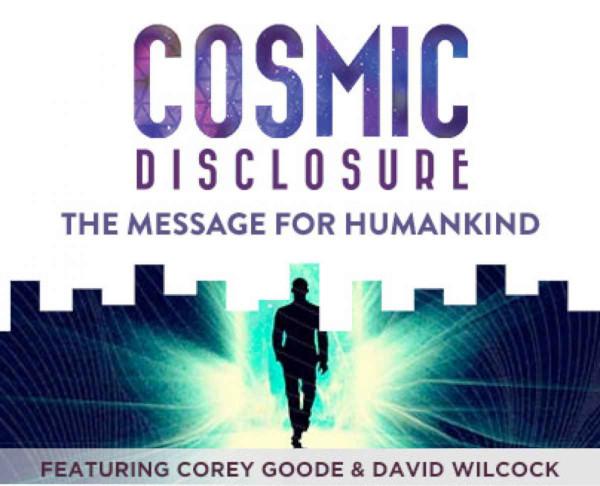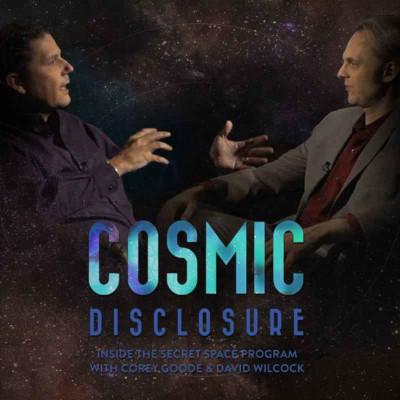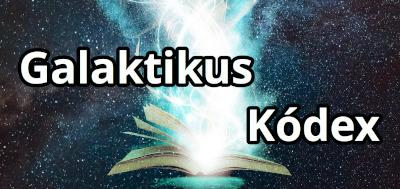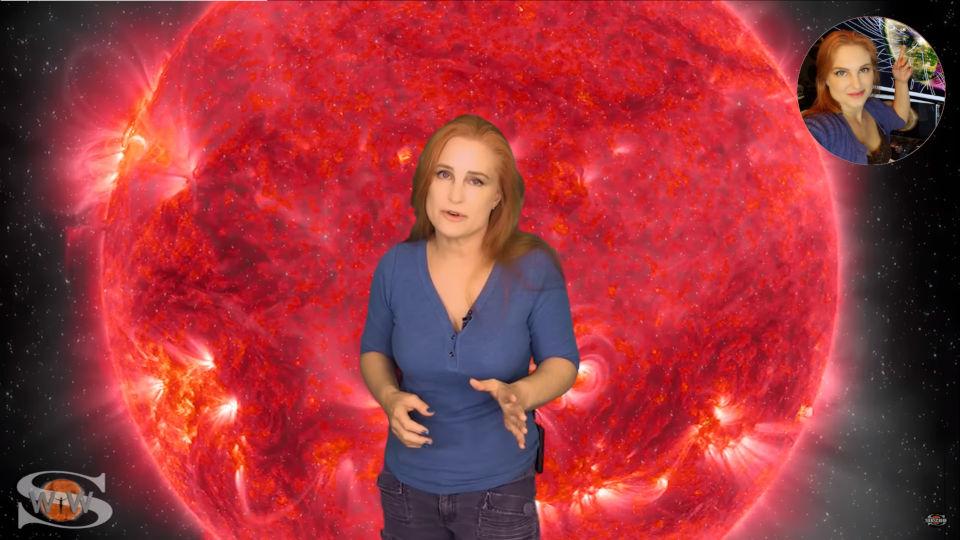Kozmikus közzététel S01E04: Élet a kutatóhajón

július 12, kedd
Kozmikus közzététel S01E04: Élet a kutatóhajón

DW: Rendben, üdvözlök mindenkit a műsorban. David Wilcock vagyok, a műsorvezető. Itt van velünk egy igazán figyelemre méltó fiatalember, akivel beszélgetünk, Corey Goode, aki bennfentesként lépett elő. Corey mesél nekünk erről a figyelemreméltó új világról, amit Titkos Űrprogramnak nevezünk. Corey, néhány ember számára nehéz lehet elfogadni a program működési területét. Természetesnek vesszük, hogy 1969-ben jártunk a Holdon. Néhányan azt mondanák, állítólag jártunk a Holdon. De minden bizonnyal úgy tűnik, hogy valóban megtettük, legalábbis csináltunk valami valódi dolgot a Holdon, majd soha többé nem mentünk vissza. Ott hagytuk a zászlót. Megcsináltunk néhány küldetést, és ó, készen is vagyunk. Láttuk, amit látnunk kellett. Tehát, azt hiszem, ha egyáltalán a Földön kívül letelepedő emberekre fogsz gondolni, akkor az emberek többsége, ha ezt el is tudná képzelni, azt mondaná: Nos, ez valószínűleg nem is olyan sok. Mi az igazi háttere annak, amivel foglalkozunk? Amikor kiderül az igazság, mit fogunk megtudni?
CG: Nos, ez elsöprő erejű lesz. Meg fogjuk tudni, hogy hatalmas infrastruktúra áll rendelkezésre az egész Naprendszerben, az aszteroidaövben végzett bányászati tevékenységektől kezdve, a holdakon és a bolygókon a nyersanyagok előállításáig, az ipari komplexumokig, amelyek technológiákat és emberi telepeket hoznak létre, amelyek ezekben az ipari komplexumokban működnek, és fenntartják ezt a nagy ipari gépezetet, amely mindenhol megtalálható a Naprendszerben.
DW: Nem tudnánk bázist építeni egy gázbolygó belsejében? Mert túl meleg és túl nagy a légnyomás?
CG: Igen, túl nagy a nyomás.
DW: Tehát ha meg akarjuk keresni ezeket a telepeket, akkor hol kellene keresnünk?
CG: Telepeknek hívjuk alapvetően azokat a helyeket, ahol a családok és az emberek élnek.
DW: Oké.
CG: Különféle típusú létesítmények állnak rendelkezésre. A kibányászandó aszteroidák belsejében vannak olyan létesítmények, amelyekkel a kitermelést végzik. Mindenfelé vannak telepek a Marson, természetesen alul, a Mars felszíne alatt, és a különféle gázóriások holdjain, sőt a saját holdunkon is.
DW: Meg tudnád becsülni, hogy hány különböző létesítmény vagy bázis épült, mondjuk a Naprendszerünkben?
CG: Naprendszerünkben van minden, a kis biztonsági helyőrségektől, amelyek csak a Marson 18–40 embert jelentenek, egészen a Naprendszer különböző Lagrange-pontjaiban lebegő létesítményekig.
DW: Meg tudnád mondani, mi az a Lagrange-pont?
CG: Olyan bolygók vagy testek közötti területekről van szó, amelyek megszakítás nélküli gravitációs vagy egyenlő gravitációs vonzóerővel rendelkeznek minden irányból, így egyfajta geoszinkron vagy álló helyzetben maradhatnak. És tényleg nem tudok konkrét számot mondani. Sok száz létesítmény van odakint.
DW: Mekkora a nagyobb létesítmények létszáma? Hány főből áll a személyzet?
CG: Nos, beszélhetünk kolóniákról, beszélünk néhány nagyobbról, amelyekben egymillió feletti ember él.
DW: Tényleg?
CG: Igen.
DW: Mit gondolsz, hányan ilyen nagyobb létszámú bázis létezik?
CG: Nem hiszem, hogy sok ilyen nagy népességű lenne, de van jó néhány százezres nagyságrendű.
DW: Egyre hidegebb van és ezért egyre nehezebb élni, ahogy távolodunk a Naptól?
CG: Itt jön képbe a fejlett technológia.
DW: Oké.
CG: Bárhol előállíthatjuk a számunkra kényelmes életkörülményeket. És még a Schumann-rezonanciát is, amely itt a Földön fordul elő. A Föld egy bizonyos vibrációs rezonanciát bocsát ki, amely egészségesen tartja a növényeket és az embereket, ezért a Schumann-rezonanciát az űrhajókba és a létesítményekbe, telepekre is bevezetik, hogy segítsenek az embereket egészségesen tartani. És a légnyomás, a gravitáció is szabályozott.
DW: Éppen a gravitációról akartam kérdezni. Nyilvánvaló, hogy a Földnek van egy bizonyos tömege, és a gravitációs gyorsulás, másodpercenként négyzetméterenként 10 méter, arányos a Föld tömegével. Tehát a holdakon a NASA szerint - erről beszélnek -, össze vissza ugrálhatsz körbe körbe.
Szóval, hogyan kompenzálják az alacsonyabb gravitációt?
CG: Nos, gravitációs padlólemezeik vannak, ugyanúgy, mint a hajóknak. Az összekapcsolt padlólemezekbe áramot vezetnek, amelyek létrehoznak egyfajta elektrogravitációs teret, így hozva létre mesterséges gravitációt.
DW: Milyen méretűek a lemezek? Van többféle méret is?
CG: Nos, a lemezek különböző méretűek, mivel különböző méretű folyosók vannak. De vannak körülbelül ilyen (2-3 hüvelyk, mutatja) vastagságú lemezek, amelyek úgy illeszkednek egymásba, mint az építőkockás gyermekjátékok.
DW: Szóval, tudnál nekünk egy kicsit több információt adni arról, hogy mik lennének a főbb kategóriák? Azt mondtad, hogy a megépítendő helyek egyik típusa, egy létesítmény, egy olyan hely lenne, ahol emberek élnek. Ez szigorúan haszonelvű, mint például egy csomó szoba, ahol alszanak, vagy van egy szép, nagy átrium vízeséssel? Vannak nagy közös találkozóhelyek, előadótermek?
CG: Amikor a kutatóhajón voltam, általában nem látogattuk meg őket. Ezek az ICC (Bolygóközi Vállalati Konglomerátum) tulajdonában voltak. Ezek a vállalatok tulajdonában lévő kolóniák voltak. Ha nem tudtak hozzáférni egy saját emberükhöz, hogy megjavítson egy kritikusan fontos gépet vagy technológiát, amely meghibásodott, akkor általában volt egy szakember a kutatóhajónkon, aki rendelkezett ezzel a szakértelemmel. És akkor, azokon a különleges alkalmakkor, szigorú utasítással mehettünk a kolóniákra, hogy ne beszéljünk vagy lépjünk kapcsolatba a létesítmények vagy a kolóniák egyetlen tagjával sem. Fegyveres őrség felügyelete alatt álltunk. Nem ajánlottak fel túrákat, nem kínáltak meg minket étellel. Egyenesen a helyszínre kísértek minket, ahol karbantartást kellett végeznünk, majd egyenesen visszakísértek a hajónkra, hogy távozzunk.
DW: Visszajöhetsz a Földre, amikor csak akarsz, amíg ezt a munkát végzed?
CG: Nem. Amikor a "20 plusz vissza" programban vagy, teljesen elvágnak a Földtől, a földi hírektől, minden földi vonatkozású dologtól. Nem kaptunk semmilyen tévéhírt, semmilyen információt arról, hogy mi történik a Földön.
DW: Hozhattál magaddal könyveket és magazinokat olvasni?
CG: Nem. Még csak fényképünk sem volt a családunkról vagy ilyesmi. Csak az volt, amit jelentkezéskor kaptál.
DW: Korábban beszéltél ezekről az okosüveg tabletekről. Hozzáfértél ezekhez, amikor a kutatóhajón voltál?
CG: Igen, amikor szolgálatban voltam.
DW: Rendben. Tudták, hogy mit csinálsz velük? Volt megfigyelési jegyzőkönyv arról, hogy mit megpróbáltál megnézni ezeken?
CG: Biztos vagyok benne, hogy volt. A kutatóhajón sokkal nyugodtabb volt a helyzet, mint ahogy hallottam, a katonai hajókon. A tudósokat mindig "okostojásoknak" hívják. Ez így teljesen rendben is volt. Sok időt töltöttem az okostáblák nézegetésével. Rengeteg időm volt a pihenésre. Mindenkinek volt redundáns kiképzése. Nem csak egy munkád volt. Engem a kommunikációra és néhány más dologra képeztek ki. De sokszor az egyik laboratóriumban voltam, amikor a többi munka már befejeződött, és órákat tölthettem azzal, hogy az üveg-tableteket nézegettem.
I’m sure there was. On the research vessel, it was a lot more laid back than I hear thing are on the military vessels. They always call the scientists “eggheads”. They were perfectly fine. A lot of time, I got to spend a lot time looking at the smart-glass pads. There was a lot of down time for me. Everybody had redundancy training. You didn’t just have one job. I was trained in doing communications and a few other things. But a lot of the time, I would be in one of the labs, when some of the other work was done, and I would just have hours to spend, looking at the glass-pads.
DW: So, let’s talk about recreation for a minute. People, are they more apt to hangout and talk to each other, or are they more apt to fuss around with the glass-pads and be alone and just try to read more interesting things.
CG: You would mainly only have access to the glass-pads when you were on duty.
DW: Oh, when you were on duty.
CG: Right, when you had off time, or you were in the galley or whatever you were going to communicate with other people and hear the scuttlebutt of what is going on.
DW: Did you have certain people that were, like, your close friends?
CG: I was mainly in tight with some of the “eggheads” or scientist because I spent a lot of time with them. And I was assigned to one bunk area that (to which) usually 18 to 24 people were assigned. And I get to know some people but people rotated in and out a lot.
DW: There was a lot of turnover?
CG: UmHm (yes)
DW: What was the kind of thing that you would talk about with these people? I mean, it’s hard for most of us watching the show to imagine what it would be like to live in this world. Does it become ordinary after a while? Does it become boring after a while?
CG: Yeah, it was very boring. We would talk about work. We would talk about what was possibly going-on back on Earth sometimes, speculate about what other people were studying when we were assigned to study certain things, just your normal kind of chit-chat.
DW: How often did you visit various facilities when you were on this research vessel? You said you were on there for 6 years before.
CG: Like I said. It was a rare occasion. There were three different times that we visited actual colonies, and we visited the industrial complexes several times to do repairs.
DW: That would be more like factory-type facility
CG: Like a factory. And there was one occasion that we actually went to a mining operation that was in the asteroid belt.
DW: What would that look like?
CG: It was really just a three-man operation inside of an asteroid. They were operating mainly robotic and remote-controlled apparatuses.
DW: Only three staff we need to run it?
CG: Three people that would rotate.
DW: What was the size of the actual construction itself? How big was this area that was built?
CG: Well, this was an extremely large asteroid and it grew larger and larger as they were mining it.
DW: How could it grow larger? I don’t understand.
CG: The inside space.
DW: The size of the hole.
CG: The size of the inside space of the hole was growing larger and larger and larger. You could see, (that) they started-off digging, and they were making more and more progress into this one large asteroid.
DW: So, if you only visited, you said, three colonies and then other industrial facilities but you were out there for six years, that doesn’t sound like the main thing you were doing.
CG: No, it wasn’t super exciting. A lot of what we did is we were studying, I guess you would call them exo-extremophiles. I guess modern biology and science are going to have to redefine what life is. Based on what I saw, the life I saw, being studied, there was plasma life, other types of energetic-type of life, that were basically like giant amoebas that were feeding off of the electromagnetic field of Jupiter. They tried to get specimens of those. They were so large, they would get small specimens that would basically die or somewhat putrefy. They weren’t able to...
DW: What was it about them that made the space program decide they were actually alive?
CG: Well. They were not just alive, they showed signs of being sentient.
DW: Really?
CG: Yeah. They were self-aware. They had preservation-of-life characteristics. There were a lot of things they did, testing on them, that I guess wouldn’t be extremely ethical to figure out...
DW: Well, I think your typical conventional view of biological life as it has to eat, it has to excrete, it has to have locomotion, it has to have respiration ...
CG: Neurology
DW: Right. You’re going to have cells, you’re going to have biological material ..
CG: Yeah. It’s carbon-base life.
DW: So this life doesn’t have cellular structure. It is not like the plasma is interconnected by cells.
CG: No. But they behaved like single-cell organisms in the way they reproduced.
DW: They actually reproduce?
CG: Yeah. What is it, Mitosis, where they split?
DW: Right.
CG: And there were also some ocean life under one of the moons of Jupiter under ice that was studied...
DW: Like Europa?
CG: Yeah, that were somewhat like whales or dolphins.
DW: Really?
CG: Yeah. So there’s quite a bit out there that the scientific people are studying.
DW: How common would biological life be in our Solar System? Where do you find it?
CG: It’s pretty much everywhere if you include on the microscopic level. It’s pretty much everywhere. You can even find it free floating in space freeze-dried.
DW: Right. When we get beyond microbial life, do you actually find little guys that can walk around on these moons, like out around the moons of Jupiter? I know you said Europa, which is a watery moon, but what about a dry moon? Would there be a life that could live inside the surface of a dry moon?
CG: There is some life on Mars. There is some small animal life that mainly is burrowing, that digs. There’s plant life on Mars that’s very... what would you call something that grow in a desert... very robust. There was this one bush that was purple and red, that has huge thorns on it. And it was kind of squatty bush, and it had pointy leaves that were like thorns at the tip that were striped purple and red.
DW: How would you go out to see those bushes? Would you wear a suit of some kind?
CG: Yeah. There was a lightweight suite, not a heavy pressure suit.
DW: Did it have like a glass helmet kind of thing?
CG: Yeah. And a respirator.
DW: So, let’s go back to the vessel for a minute. How many people did you bunk with on the vessel?
CG: It ebbed and flowed. There were up to 24 people that could stay in the area that I was assigned. It was anywhere from 18 and 24. It would change.
DW: So, you were contained, and you had to sleep all together in one room. Like the military style?
CG: Yeah. And we had bunks that were into the walls, and we would sit in the bunk. You would sit in your bunk, close your divider and you had a little organizer section that you could put whatever items you had.
DW: Did they keep you on a 24-hour cycle like on Earth? It’s the same kind of measurement of time?
CG: Right
DW: Did they light the ship in any way that would indicate to your body that you’re on a cycle?
CG: They tried to keep a circadian cycle going and pipe the Schumann resonance in, to keep everything, what the human body is used to for health reasons.
DW: Did some people work the night shift?
CG: Oh yeah. Constantly, people were on duty.
DW: How are you getting water? Obviously water on Earth, requires a hydrological cycle with clouds and rains. Water’s so scarce on Earth now, with California’s drought. How do you guys have it, in the middle of space?
CG: Water in not scarce in the Solar System. And when you’re on board a vessel like that. Let’s just put it this way, everything is recycled.
DW: So the whole ship is designed to recycled everything
CG: It’s a very closed system, self-contained closed system. Yeah, everything is recycled.
DW: Do you end having to become vegetarian, or do people that like to eat meat still get a chance to eat something like meat? What are your meals?
CG: The quality of them has changed but, they had replicator that produced a certain range of meals. But they also had hydroponic areas where they grew some fresh foods.
DW: So, could you hit the button for “cheeseburger” on a replicator and get a cheeseburger
CG: No. It wasn’t like that. No. You would hit a button and get a pot-roast or something like that.
DW: What were your favorite things the replicator made? Could you give us a list of what...
CG: I would get the pot-roast a lot and mashed potatoes
DW: Was it a fairly convincing pot roast? Did it actually taste like a pot roast?
CG: It tasted good, yeah.
DW: It came out at the right temperature? Did you then have to heat it once it was made?
CG: No, it came out at a hot temperature.
DW: Could you see the food being formed inside through glass, or was-it dark?
CG: It looks basically like a microware, the size. And you put in a plate, right on the area designed for the –plate, close the door, you push the button of what you want, and it makes a noise, and it appears. And you open it, you pull it out, and there’s steaming food.
DW: What kind of noise was it?
CG: Similar to a microwave. When they would replicate something, would call it “printing something”.
DW: Really?
CG: Yeah
DW: Was there a name for the device? Did you call it something?
CG: A printer
DW: Really?
CG: Yeah
DW: How did you know what you were going to get? Was there like a digital display that you could choose from a menu that you’d scroll through or something?
CG: If you were to look at a microwave, you have a certain amount a button that you can push...
DW: So there was a pot-roast button?
CG: Yeah. There was a button for different meals.
DW: What about beverages? Could you get like a lemonade or a fruit punch?
CG: Yeah, but you didn’t get that through the replicator. There were dispenser for different beverages
DW: Did you grow the vegetables separately from the replicator? Like, you can’t print a salad.
CG: Well, there were some vegetables like potatoes and stuff like that, but some of the other greens vegetables they would grow.
DW: Okay. So, if you wanted to have a salad, is the vending of the salad near where the printer is? Do you have a refrigerator where the greens are kept?
CG: That’s when you’d go through the galley area, and have certain things that were prepared. You would have times, when things would malfunction, and you would have to have powered eggs and ration foods and stuff like that. They had a galley area where they had people that would serve food slop.
DW: What were you wearing when you worked on this vessel?
CG: Jumpsuits.
DW: So, single piece?
CG: Yeah.
DW: What was the color?
CG: Well, different designations, different colors. Sometimes blue, sometimes white.. It just depended on what area you were working in.
DW: What would the white designate?
CG: White – It wasn’t really a designation of a job. If I was working in the lab area with the “eggheads” or whatever, I would wear the white. If I was working in the communication area, I wouldn’t wear the white lab jumpsuit.
DW: If you went to the front of the ship and then you walked at a steady pace to the back, how long would that take if you were to do the whole circuit?
CG: You couldn’t walk straight. It was like a maze. Probably take you like 30, 45 minutes of walking all around if you stayed on one level.
DW: Is there a predominant look to the walls when you’re inside? What’s the predominant color of what you’re seeing inside?
CG: Well, a lot of them were just metal. I was told that a lot of these first craft were built by people that built submarines. So it had a lot of the same type of feel and build. And in case there was ever a zero-G environment, there were handles along the wall that you would use to guide yourself.
DW: What was your typical ceiling height inside?
CG: Probably about eight feet.
DW: Did you have multiple decks, like, you could go from one floor to another?
CG: Yeah. There were multiple decks.
DW: Do you remember how many decks?
CG: I mainly stayed within four decks, but I believe there were at least nine decks.
DW: Did they have a specific classification, like a name for each deck?
CG: Yeah. They had designations for each area. There would be “level 1”. Then the dash (-), they would call it a tack, like “1 tack A” (1-A), “1 tack B” (1-B).
DW: Were any of these areas color-coded? Like, the walls looked a certain way to let you know you’re in a certain place?
CG: Well, something that was popular would be the colored lines on the floor that would lead you. But pretty much, you would know where you were going by the designation of the number on the door.
DW: You had said that the Alliance intends to handover this technology to humanity once we go through disclosure.
CG: Yeah. That’s the plan. After there’s a full disclosure, and after we go through the process of dealing with the full disclosure information and get past whatever trials that are needed and psychologically deal with the process, then all these technologies are going to be brought down to humanity to basically change our lives from us being debt-slaves working every day, working eight or nine hours a day to pay rent and watch TV for a few hours, go to sleep, and then repeat every day, to having a totally different type of life.
DW: Who decides who gets to go out into space? Is there going to be some restrictions on who’s allowed to go?
CG: I have no idea how that’s going to work out. I know that supposedly, it’s going to be a Star Trek-type civilization. I know eventually there’s going to be tourism to a lot of places in the Solar System. And there’s going to be a lot of new career-types for people.
DW: Do you think there are enough ships that a lot of people here could go pretty quickly if they wanted to, once this all opens up?
CG: I believe so. Yeah. I believe there’s quite enough craft already created that we could use those for non-military purposes.
DW: Well, this has been really incredible. So again, I want to thank you for being here, and I want to thank you for watching. When you start to get this much specific details... You can tell pretty much when people are lying. They start to hesitate, and their body-language changes. And I’ve been talking to you for so long about this stuff, and every time I ask you these questions, I learn new things. And I’m convinced that what you are telling us, did happen to you. I think there is extensive evidence to prove that, based on how it correlates with everything else. So again, I consider you a hero for coming forward, and I really want to thank you for your service to humanity in doing this.
CG: Thank you.
DW: Thanks






Hozzászólások